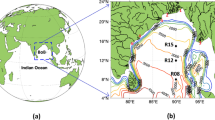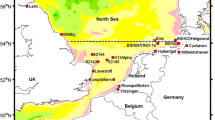Abstract
The influence of a summer storm event in 2007 on the North Sea and its effects on the ocean stratification are investigated using a regional coupled ocean (Regional Ocean Modeling System, ROMS)-atmosphere (Weather Research & Forecasting model, WRF) modeling system. An analysis of potential energy anomaly (PEA, Φ) and its temporal development reveals that the loss of stratification due to the storm event is dominated by vertical mixing in almost the entire North Sea. For specific regions, however, a considerable contribution of depth-mean straining is observed. Vertical mixing is highly correlated with wind induced surface stresses. However, peak mixing values are observed in combination with incoming flood currents. Depending on the phase between winds and tides, the loss of stratification differs strongly over the North Sea. To study the effects of interactive ocean-atmosphere exchange, a fully coupled simulation is compared with two uncoupled ones for the same vertical mixing parameters to identify the impact of spatial resolution as well as of SST feedback. While the resulting new mixed layer depth after the storm event in the uncoupled simulation with lower spatial and temporal resolution of the surface forcing data can still be located in the euphotic zone, the coupled simulation is capable to mix the entire water column and the vertical mixing in the uncoupled simulation with higher resolution of the surface forcing data is strongly amplified. These differences might have notable implications for ecosystem modeling since it could determine the development of new phytoplankton blooms after the storm and for sediment modeling in terms of sediment mobilization. An investigation of restratification after the extreme event illustrates the persistent effect of this summer storm.

















Similar content being viewed by others
References
Aarup T (2002) Transparency of the North Sea and Baltic Sea, a Secchi Depth data mining study. Oceanologia 44(3):323–337
Berg P, Wagner S, Kunstmann H, Schaedler G (2013) High resolution regional climate model simulations for Germany: part I validation. Clim Dyn 40(1-2):401–414. doi:10.1007/s00382-012-1508-8
Berrisford P, Dee D, Fielding K, Fuentes M, Kallberg P, Kobayashi S, Uppala S (2009) The ERA-Interim archive. Technical. report, ECMWF, ERA Report Series 1, pp 16
Berrisford P, Kallberg P, Kobayashi S, Dee D, Uppala S, Simmons AJ, Poli P, Sato H (2011) Atmospheric conservation properties in ERA-Interim. Q J Royal Meteorol Soc 137(659):1381–1399. doi:10.1002/qj.864
Booij N, Ris RC, Holthuijsen LH (1999) A third-generation wave model for coastal regions: 1. Model description and validation. J Geophys Res: Oceans 104(C4):7649–7666. doi:10.1029/98JC02622
Burchard H, Hofmeister R (2008) A dynamic equation for the potential energy anomaly for analysing mixing and stratification in estuaries and coastal seas. Estuar, Coast Shelf Sci 77(4):679–687. doi:10.1016/j.ecss.2007.10.025, http://www.sciencedirect.com/science/article/pii/S0272771407004945
Carlotti F, Radach G (1996) Seasonal dynamics of phytoplankton and Calanus finmarchicus in the North Sea as revealed by a coupled one-dimensional model. Limnol Oceanogr 41(3):522–539. doi:10.4319/lo.1996.41.3.0522
Chassignet EP, Hurlburt HE, Smedstad OM, Halliwell GR, Hogan PJ, Wallcraft AJ, Baraille R, Bleck R (2007) The HYCOM (HYbrid Coordinate Ocean Model) data assimilative system. J Mar Syst 65(1-4):60–83. doi:10.1016/j.jmarsys.2005.09.016, http://www.sciencedirect.com/science/article/pii/S0924796306002855, marine Environmental Monitoring and Prediction Selected papers from the 36th International Liege Colloquium on Ocean Dynamics 36th International Liege Colloquium on Ocean Dynamics
de Boer GJ, Pietrzak JD, Winterwerp JC (2008) Using the potential energy anomaly equation to investigate tidal straining and advection of stratification in a region of freshwater influence. Ocean Modell 22(1–2):1 – 11. doi:10.1016/j.ocemod.2007.12.003, http://www.sciencedirect.com/science/article/pii/S1463500307001631
Delhez E, Damm P, De Goede E, De Kok J, Dumas F, Gerritsen H, Jones J, Ozer J, Pohlmann T, Rasch P, Skogen M, Proctor R (2004) Variability of shelf-seas hydrodynamic models: lessons from the NOMADS2 Project. J Mar Syst 45(1-2):39–53. doi:10.1016/j.jmarsys.2003.09.003, http://www.sciencedirect.com/science/article/pii/S0924796303001313
Egbert GD, Erofeeva SY (2002) Efficient inverse modeling of barotropic ocean tides. J Atmosheric Ocean Technol 19:183–204
Egbert GD, Bennett AF, Foreman MGG (1994) TOPEX/POSEIDON tides estimated using a global inverse model. J Geophys Res: Oceans 99(C12):24,821–24,852. doi:10.1029/94JC01894
Gräwe U, Holtermann P, Klingbeil K, Burchard H (2015) Advantages of vertically adaptive coordinates in numerical models of stratified shelf seas. Ocean Modell 92:56–68. doi:10.1016/j.ocemod.2015.05.008, http://www.sciencedirect.com/science/article/pii/S1463500315000979
Groeger M, Dieterich C, Meier M, Schimanke S (2015) Thermal air-sea coupling in hindcast simulations for the North Sea and Baltic Sea on the NW European shelf. Tellus A 67, http://www.tellusa.net/index.php/tellusa/article/view/26911
Haidvogel D, Arango H, Budgell W, Cornuelle B, Curchitser E, Lorenzo ED, Fennel K, Geyer W, Hermann A, Lanerolle L, Levin J, McWilliams J, Miller A, Moore A, Powell T, Shchepetkin A, Sherwood C, Signell R, Warner J, Wilkin J (2008) Ocean forecasting in terrain-following coordinates: Formulation and skill assessment of the Regional Ocean Modeling System. J Comput Phys 227(7):3595–3624. doi:10.1016/j.jcp.2007.06.016, http://www.sciencedirect.com/science/article/pii/S0021999107002549
Haney RL (1991) On the pressure gradient force over steep topography in sigma coordinate ocean models. J Phys Oceanogr 21:610–619
Hofmeister R, Burchard H, Bolding K (2009) A three-dimensional model study on processes of stratification and destratification in the Limfjord. Cont Shelf Res 29:1515–1524. doi:10.1016/j.csr.2009.04.004
Holt J, Umlauf L (2008) Modelling the tidal mixing fronts and seasonal stratification of the Northwest European Continental shelf. Cont Shelf Res 28(7):887–903. doi:10.1016/j.csr.2008.01.012, http://www.sciencedirect.com/science/article/pii/S0278434308000241
Holt JT, James ID (1999) A simulation of the Southern North Sea in comparison with measurements from the North Sea Project. Part 1: Temperature. Cont Shelf Res 19(8):1087–1112. doi:10.1016/S0278-4343(99)00015-1
Jacob R, Larson J, Ong E (2005) M x N communication and parallel interpolation in CCSM3 using the model coupling toolkit. Int J High Perform Comput Appl 19:293–307
Larson J, Jacob R, Ong E (2005) The model coupling toolkit: a new Fortran90 toolkit for building multiphysics parallel coupled models. Int J High Perform Comput Appl 19:277–292
Lenhart HJ, Pohlmann T (2004) North Sea hydrodynamic modelling: a review. Senckenberg Marit 34 (1-2):53–88. doi:10.1007/BF03043229
LMA (1985) Europe - Encyclopaedia Britannica Macropaedia, vol 18, 15th edn. Encyclopaedia Britannica Inc., pp 832–835
Loewe P, Klein H, Weigelt-Krenz S (2013) System Nordsee : Zustand und Entwicklungen. Berichte des BSH. Tech report. Bundesamt für Seeschifffahrt und Hydrographie, Hamburg and Rostock
Mathis M, Mayer B, Pohlmann T (2013) An uncoupled dynamical downscaling for the North Sea. Method and evaluation. Ocean Modelling 72:153–166. doi:10.1016/j.ocemod.2013.09.004, http://www.sciencedirect.com/science/article/pii/S1463500313001662
Merino M, Monreal MA (2004) Ocean currents and their impact on marine life, in Marine Ecology, Encyclopedia of Life Support Systems (EOLSS). EOLSS, Oxford, U. K
Oey LY, Ezer T, Wang DP, Fan SJ, Yin XQ (2006) Loop Current warming by Hurricane Wilma. Geophys Res Lett 33(8):1–4. doi:10.1029/2006GL025873
Perrie W, Ren X, Zhang W, Long Z (2004) Simulation of extratropical Hurricane Gustav using a coupled atmosphere-ocean-sea spray model. Geophys Res Lett 31(3):1–4. doi:10.1029/2003GL018571
Pohlmann T (1996) Calculating the development of the thermal vertical stratification in the North Sea with a three-dimensional baroclinic circulation model. Continental Shelf Research 16(2):163–194. doi:10.1016/0278-4343(95)00018-V
Pullen J, Doyle JD, Haack T, Dorman C, Signell RP, Lee CM (2007) Bora event variability and the role of air-sea feedback. J Geophys Res-Oceans 112(C3):1–17. doi:10.1029/2006jc003726, <Go to ISI>://WOS000244370600001
Purkiani K, Becherer J, Floeser G, Gräwe U, Mohrholz V, Schuttelaars HM, Burchard H (2015) Numerical analysis of stratification and destratification processes in a tidally energetic inlet with an ebb tidal delta. J Geophys Res: Oceans 120(1):225–243. doi:10.1002/2014JC010325
Reynolds RW, Smith TM, Liu C, Chelton DB, Casey KS, Schlax MG (2007) Daily high-resolution-blended analyses for sea surface temperature. J Climat 20:5473–5496
Schrum C, Hübner U, Jacob D, Podzun R (2003) A coupled atmosphere-ice-ocean model for the North Sea and the Baltic Sea. Climat Dyn 21(2):131–151. doi:10.1007/s00382-003-0322-8
Schrum C, Alekseeva I, John MS (2006) Development of a coupled physical-biological ecosystem model ECOSMO: Part I: Model description and validation for the North Sea. J Mar Syst 61(1-2):79–99. doi:10.1016/j.jmarsys.2006.01.005, http://www.sciencedirect.com/science/article/pii/S0924796306000297
Sharples J, Simpson J (1993) Periodic frontogenesis in a region of freshwater influence. Estuaries 16(1):74–82. doi:10.2307/1352765
Shchepetkin AF, McWilliams JC (2005) The regional oceanic modeling system (ROMS): a split-explicit, free-surface, topography-following-coordinate oceanic model. Ocean Modell 9(4):347–404. doi:10.1016/j.ocemod.2004.08.002, http://www.sciencedirect.com/science/article/pii/S1463500304000484
Simpson J (1971) Density stratification and microstructure in the western Irish sea. Deep Sea Res Oceanogr Abstr 18(3):309–319. doi:10.1016/0011-7471(71)90036-2
Simpson J, Bowers D (1981) Models of stratification and frontal movement in shelf seas. Deep Sea Res Part A Oceanogr Res Pap 28(7):727–738. doi:10.1016/0198-0149(81)90132-1
Simpson J, Crisp DJ, Hearn C (1981) The shelf-sea fronts: implications of their existence and behaviour [and discussion]. Philosophical Transactions of the Royal Society of London A: Mathematical. Phys Eng Sci 302 (1472):531–546. doi:10.1098/rsta.1981.0181
Simpson J, Brown J, Matthews J, Allen G (1990) Tidal straining, density currents, and stirring in the control of estuarine stratification. Estuaries 13(2):125–132. doi:10.2307/1351581
Simpson JH, Hunter JR (1974) Fronts in the Irish Sea. Nature 250:404–406
Skamarock WC, Klemp JB, Dudhia J, Gill DO, Barker DM, Duda MG, Huang X, Wang W, Powers JG (2008) A description of the advanced research WRF version 3. Tech. report, 459. NCAR Boulder, Colorado, USA
Skogen MD, Drinkwater K, Hjøllo SS, Schrum C (2011) North Sea sensitivity to atmospheric forcing. J Mar Syst 85(3-4):106–114. doi:10.1016/j.jmarsys.2010.12.008, http://www.sciencedirect.com/science/article/pii/S0924796310002241
Small RJ, Carniel S, Campbell T, Teixeira J, Allard R (2012) The response of the Ligurian and Tyrrhenian Seas to a summer Mistral event: a coupled atmosphere-ocean approach. Ocean Modell 48:30–44
Souza AJ, Simpson JH (1997) Controls on stratification in the Rhine ROFI system. J Mar Syst 12(1-4):311–323. doi:10.1016/S0924-7963(96)00105-4
Sun J, Oey LY, Chang R, Xu F, Huang SM (2015) Ocean response to typhoon Nuri (2008) in western Pacific and South China Sea. Ocean Dyn 65(5):735–749. doi:10.1007/s10236-015-0823-0
USDC (2009) Ecosystem Assessment Program, Ecosystem Assessment Report for the Northeast U.S. Continental Shelf Large Marine Ecosystem. U.S. Dept. Commer, Northeast Fish Sci Cent Ref Doc. 09-11, 61 p.
Van der Lee EM, Umlauf L (2011) Internal wave mixing in the Baltic Sea: Near-inertial waves in the absence of tides. J Geophys Res: Oceans 116(C10):c10016
Van Leeuwen S, Tett P, Mills D, Van der Molen J (2015) Stratified and nonstratified areas in the North Sea: Long-term variability and biological and policy implications. J Geophys Res: Oceans 120(7):4670–4686. doi:10.1002/2014JC010485
Van Haren H, Maas L, Zimmerman JTF, Ridderinkhof H, Malschaert H (1999) Strong inertial currents and marginal internal wave stability in the central North Sea. Geophys Res Lett 26(19):2993–2996
Warner JC, Sherwood CR, Arango HG, Signell RP (2005) Performance of four turbulence closure models implemented using a generic length scale method. Ocean Modell 8(1-2):81–113. doi:10.1016/j.ocemod.2003.12.003, http://www.sciencedirect.com/science/article/pii/S1463500303000702 http://www.sciencedirect.com/science/article/pii/S1463500303000702
Warner JC, Sherwood CR, Signell RP, Harris CK, Arango HG (2008) Development of a three-dimensional, regional, coupled wave, current, and sediment-transport model. Comput Geosci 34(10):1284–1306. doi:10.1016/j.cageo.2008.02.012, http://www.sciencedirect.com/science/article/pii/S0098300408000563
Warner JC, Armstrong B, He R, Zambon JB (2010) Development of a coupled ocean-atmosphere-wave-sediment transport (COAWST) modeling system. Ocean Modell 35(3):230–244. doi:10.1016/j.ocemod.2010.07.010, http://www.sciencedirect.com/science/article/pii/S1463500310001113 http://www.sciencedirect.com/science/article/pii/S1463500310001113
Acknowledgments
We would like to thank the International Research Training Group INTERCOAST and the Deutsche Forschungsgemeinschaft (DFG) for funding for this study. Atmospheric surface data for evaluation were kindly provided by the German Deutsche Wetterdienst (DWD) and the National Center for Environmental Predictions (NCEP). We acknowledge the public deployment of very valuable information and different tools for pre- and post-processing of ROMS and WRF data by the ROMS/TOMS Group, ROMS AGRIF (ROMSTOOLS), Emanuele Di Lorenzo (ROMS Numerical Toolbox), Hernan G. Arango, John C. Warner and the COAWST team, and MMM/NCAR. Many thanks to Mark Hadfield and colleagues for the support and fruitful discussions and also for the possibility to visit and work at the NIWA Wellington during a part of this study. Further thanks for valuable general discussions regarding the COAWST system, the PEA analysis, and North Sea modeling are going to A. Aretxabaleta, H. Burchard, T. Pohlmann and colleagues, and J. C. Warner and colleagues. We also would like to thank the two anonymous reviewers, who clearly helped with their very constructive, detailed, and careful comments to improve this work.
Author information
Authors and Affiliations
Corresponding author
Additional information
Responsible Editor: Birgit Andrea Klein
Rights and permissions
About this article
Cite this article
Gronholz, A., Gräwe, U., Paul, A. et al. Investigating the effects of a summer storm on the North Sea stratification using a regional coupled ocean-atmosphere model. Ocean Dynamics 67, 211–235 (2017). https://doi.org/10.1007/s10236-016-1023-2
Received:
Accepted:
Published:
Issue Date:
DOI: https://doi.org/10.1007/s10236-016-1023-2




